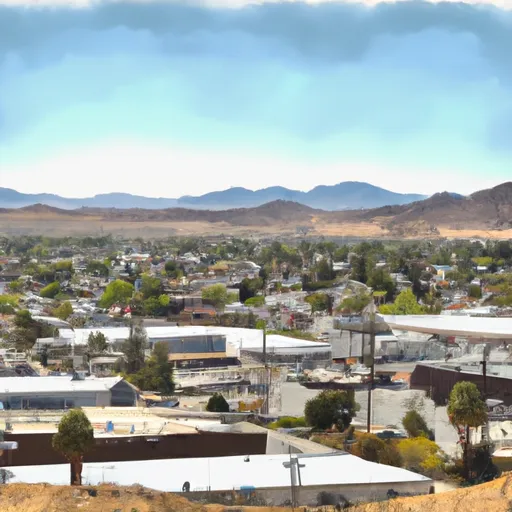-
 Snoflo Premium
Snoflo Premium
Get unlimited access to all our content
With no Ad interruptions! - Start Your Free Trial Login with existing account
Yucca-Valley
Eden Index
Climate
8.8
•
Recreation
5.0
•
Community
1.9
•
Safeguard
5.8/10

Yucca Valley is a charming town located in the Mojave Desert of Southern California. Known for its stunning natural beauty and clear skies, it offers a unique desert climate and a variety of outdoor activities.
The climate in Yucca Valley is characterized by hot summers and mild winters. Summers can be scorching, with temperatures often exceeding 100°F (37°C), while winters are generally mild with average temperatures around 60°F (15°C). The area receives very little rainfall, averaging around 5 inches per year.
Hydrologically, Yucca Valley is situated on the top of the Yucca Valley Groundwater Basin, which serves as the primary water source for the region. The basin provides clean and reliable drinking water for the area's residents.
Outdoor enthusiasts can take advantage of the numerous recreational opportunities available in Yucca Valley. Joshua Tree National Park is nearby, offering breathtaking desert landscapes, hiking trails, rock climbing, and camping opportunities. The town also has several parks and preserves, providing opportunities for picnicking, bird watching, and nature walks. Additionally, visitors can enjoy off-roading, horseback riding, and stargazing due to the area's clear skies and lack of light pollution.
In summary, Yucca Valley, California, offers a desert climate with hot summers and mild winters. The town benefits from the Yucca Valley Groundwater Basin, providing a reliable water supply. Outdoor enthusiasts can engage in various activities such as exploring Joshua Tree National Park, hiking, camping, and stargazing.
What is the Eden Index?
The Snoflo Eden Index serves as a comprehensive rating system for regions, evaluating their desirability through a holistic assessment of climate health, outdoor recreation opportunities, and natural disaster risk, acknowledging the profound impact of these factors on livability and well-being.
Climate Health Indicator (CHI): 8.8
Yucca-Valley receives approximately
223mm of rain per year,
with humidity levels near 60%
and air temperatures averaging around
17°C.
Yucca-Valley has a plant hardyness factor of
8, meaning
plants and agriculture in this region tend to thrive here all year round.
By considering the ideal temperature range, reliable water supplies, clean air, and stable seasonal rain or snowpacks, the Climate Health Indicator (CHI) underscores the significance of a healthy climate as the foundation for quality living.
A healthy climate is paramount for ensuring a high quality of life and livability in a region, fostering both physical well-being and environmental harmony. This can be characterized by ideal temperatures, reliable access to water supplies, clean air, and consistent seasonal rain or snowpacks.
Weather Forecast
Streamflow Conditions
Southern Mojave
Area Rivers
Southern Mojave
Snowpack Depths
Southern Mojave
Reservoir Storage Capacity
Southern Mojave
Groundwater Levels
Recreational Opportunity Index (ROI): 5.0
The Recreational Opportunity Index (ROI) recognizes the value of outdoor recreational options, such as parks, hiking trails, camping sites, and fishing spots, while acknowledging that climate plays a pivotal role in ensuring the comfort and consistency of these experiences.
Access to outdoor recreational opportunities, encompassing activities such as parks, hiking, camping, and fishing, is crucial for overall well-being, and the climate plays a pivotal role in enabling and enhancing these experiences, ensuring that individuals can engage in nature-based activities comfortably and consistently.
Camping Areas
| Campground | Campsites | Reservations | Toilets | Showers | Elevation |
|---|---|---|---|---|---|
| Bighorn Mountain Wilderness Dispersed | 30 | 2,697 ft | |||
| Black Rock - Joshua Tree National Park | 100 | 3,962 ft |
Catastrophe Safeguard Index (CSI):
The Catastrophe Safeguard Index (CSI) recognizes that natural disaster risk, encompassing floods, fires, hurricanes, and tornadoes, can drastically affect safety and the overall appeal of an area.
The level of natural disaster risk in a region significantly affects safety and the overall livability, with climate change amplifying these risks by potentially increasing the frequency and intensity of events like floods, fires, hurricanes, and tornadoes, thereby posing substantial challenges to community resilience and well-being.
Community Resilience Indicator (CRI): 1.9
The Community Resilience Indicator (CRI) recognizes that education, healthcare, and socioeconomics are crucial to the well-being of a region. The CRI acknowledges the profound impact of these elements on residents' overall quality of life. By evaluating educational resources, healthcare accessibility, and economic inclusivity, the index captures the essential aspects that contribute to a thriving community, fostering resident satisfaction, equity, and social cohesion.

